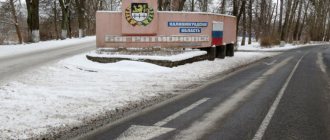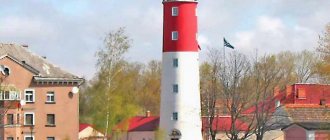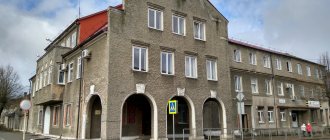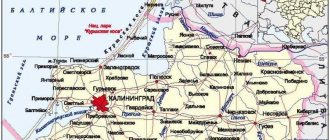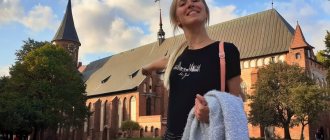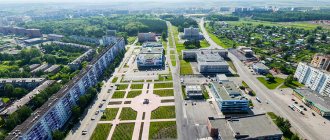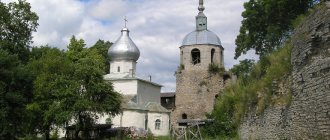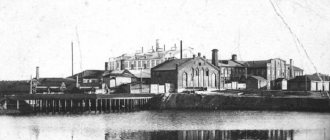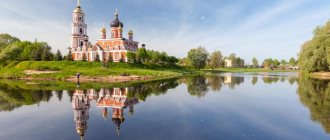About the history of the city
Interestingly, until 1947 Svetly was called Zimmerbude (which translated from German means “hut, shack”). It was a simple Prussian fishing village, the first mention of which in written sources dates back to the mid-15th century. And another nearby village - Paize (now the village of Komsomolsky) - is mentioned in a manuscript of 1305.
In the middle of the 15th century, on the site of modern Svetly, fortress walls were erected and the “fishing estate” of the Bishop of Zemland was founded. After the seizure of church lands by secular authorities, the estate came into the possession of the noble nobleman Oswald von Taubenheim, and in 1669 - Eberhard von Dunckelmann, the former tutor of King Frederick I.
The inhabitants of Zimmerbud were mainly engaged in fishing. They had no arable land, with the exception of home gardens. They kept livestock and cut hay in the meadows. In general, people lived here very poorly, and the village fully lived up to its name. The matter was aggravated by regular floods that occurred in these places. Gradually, the old bishop's castle also collapsed from them.
Medieval sources describe Zimmerbud as a collection of cramped and dirty huts with reed-covered roofs. Residents wore unsightly homemade clothes, which they spun, wove and sewed with their own hands. Everyone was very religious, although the nearest church was in Medenau (Logvino), and it was difficult to visit it due to bad roads.
Only in 1901 did Zimmerbud have its own small church: together with the neighboring villages of Paise and Nepleken, its residents formed their own church community. By this time, the village already looked much more civilized and nice. By the beginning of World War II, it was a small, neat village with more than a thousand residents and a new school built in the 20s; shop; tavern; bakery; Hotel "Waldschloschen" ("Forest House").
Soviet store located in an old German building
This building still stands. Behind it there used to be a lake with mineral water (mineral springs came out of the ground). A piece of this once mineral lake still remains behind the market, but overall it has already turned into a wetland.
The revitalization and growth of prosperity in Zimmerbud, Peise and Nepleken was facilitated by the construction of the Königsberg-Pillau shipping canal (it was in operation from 1894 to 1901). The floods stopped, permanent convenient harbors and pavements were established in fishing villages, and a power station appeared; the railroad came here. In Paisa, a sports society even started working and became extremely popular; a powerful football team was founded.
There were no military operations on the territory of provincial Zimmerbud, and therefore the village was not subject to destruction. After the war, in 1947, the village was renamed the village of Svetloye. In 1949 it became known as the working settlement of Svetly, and in 1955 it received the status of a city.
Soon after the war, thanks to the power plant and the canal, city-forming enterprises appeared in Svetloye: the fishing collective farm “For the Motherland!” and a fish canning plant and a ship repair plant. Their workers built the entire city. For a long time, for building materials, slag was taken from GRES-2, mixed with cement, poured between wooden slabs, and a monolith was obtained.
The most important attraction of Svetly is the Kaliningrad Sea Shipping Canal.
Bus Kaliningrad - Svetly
The only type of public transport in this direction. Transportation is carried out by the Regio-Express motor transport company, which serves two routes - No. 105 and No. 108 (via Lyublino).
The landing place is the Southern Bus Station of Kaliningrad. In Svetly there are several stops around the city (along Kaliningradskaya Street).
Bus 105 Kaliningrad - Svetly
Photo: © AlekseyMescheryacov
Direct regular municipal route. Buses run daily from morning to evening. The first flight on weekdays and Saturdays is at 06:30, the last flight is at 22:45, the interval between departures is 20–40 minutes.
The first flight on Sundays is at 07:25, the last flight is at 22:45, the interval is 30 minutes.
Travel time is 1 hour 10 minutes. The final time depends on the current traffic congestion.
In Kaliningrad, the bus stops at stops located on the section from Bagration Street to Mendeleev Street.
Bus 108 Kaliningrad - Svetly
Photo: © Caramba
This is another, alternative route. It is less convenient, since the bus travels through Lyublino. In addition, there are only three flights per day - at 08:50, 15:25, 18:55.
Travel time is 1 hour 20 minutes.
There are stops around the city for picking up passengers - “Bagration”, “Museum of Fine Arts”, “Hotel Kaliningrad”, “Northern Station”, “Narvskaya Street”. All of them are on demand.
Among the obligatory stops along the way are Old Lyublino and New Lyublino. The rest are also on request.
Bus schedule Kaliningrad - Svetly 2022
The current schedule can be found on the official website. By the way, the carrier notifies that on pre-holidays and public holidays, taking into account passenger traffic, changes in the schedule are possible.
In addition, the summary schedule is available on the official website of the Kaliningrad bus station. Tickets are also sold there (after registering the passenger’s personal account).
Kaliningrad Sea Shipping Canal
This is a hydraulic structure located in the Kaliningrad Bay. It stretches 43 kilometers, from the military harbor of Baltiysk along the northern shore of the Kaliningrad Bay to the Kaliningrad port. The width of the canal is from 50 to 80 meters, and its depth is 9-10 meters.
The canal was fenced off from the bay by ten artificial artificial islands. They are overgrown with forest and protect the canal fairway from the waters and sediments of the bay. The canal is navigable year-round, although in winter it can be covered with a thin crust of ice. Vessels are up to 200 m long, with a draft of up to 8 m and a carrying capacity of up to 30 thousand tons.
Kaliningrad Sea Shipping Canal
In the city of Svetly, the Kaliningrad Sea Canal is bordered by a picturesque embankment. On warm and fine days, it always becomes the most popular public area in this city, where walkers, vacationers and fishermen spend their time.
Climate[edit]
The climate is influenced by the prevailing air mass from the Atlantic Ocean to the mainland and is characterized by a transition to the sea with mild winters with little snow, relatively cold springs, moderately warm summers and warm, humid autumns. The average annual temperature is 6.8 °C (44.2 °F). The annual temperature range can be large, from +35°C (95°F) in July-August to -33°C (-27°F) in January-February.
The average January temperature is −3.4 °C (25.9 °F). 86 days a year with frost. Severe frosts are rare. The warmest period is the month of July, when the average temperature is 17.5 °C (63.5 °F). In general, weather conditions are unstable and are associated mainly with the predominance of high-frequency maritime air masses that accompany cyclones (storms).
Humid air masses coming from the Atlantic Ocean cause high relative humidity, which in winter drops by 85-87%, decreasing to 72-73% by the beginning of summer. High humidity and large clouds significantly affect the characteristics (decrease) of the Light mode.
During the year there are about 150 cloudy and only 30 clear days. On average, 74 days with fog are recorded per year, mostly fog in winter. They are accompanied by drizzle, rain and snow. Annual precipitation amounts to 700–750 mm (27.6–29.5 in), most of it occurring during the warm months. Maximum in August - up to 90 mm (4 inches), minimum - in February - March. During the winter months, only 8-10% of annual precipitation falls. The snow depth is small - 13–18 cm (5–7 inches).
The study area is typically an area of active wind activity. The wind regime is characterized by the predominance of winds from the southern and western regions with a frequency of 35%, as well as from the southern and south-eastern regions with a frequency of 23%. The average annual wind speed is 3.7 meters per second (12.1 ft/s). Has the highest wind speed. In winter, its average speed is 5.5 m/s (18.0 ft/s). The number of days with strong winds (storms) greater than 15 m/s (49.2 ft/s) up to 10–15 days.
Pavel Nakhimov Boulevard and the bust of this famous naval commander
Nakhimov Boulevard is a beautiful street-alley in the city of Svetly, created back in the early 60s by local city enthusiasts. It is small and cozy, ideal for walking and relaxing.
Bust of Pavel Nakhimov
A bust of the famous Russian admiral Pavel Stepanovich Nakhimov (1802-1855) was installed on the boulevard named after him in July 2015.
Mosaic panel “To Kaliningrad fishermen”
A large-scale mosaic panel dedicated to Kaliningrad fishermen is located on the northwestern and northeastern facades of the Atlantic department store in the city of Svetly. This is the work of husband-and-wife artists Yuri and Nelly Smirnyagin, created in 1967-1968. These masters created many masterpieces of the now bygone style of socialist realism.
The composition of the mosaic in Svetly consists of two interconnected parts. The first of them depicts the daily work of fishermen at sea; reflects the romance of the “sea soul” and the fishing profession. The second is the desire for this romance of youth: in it, young athletes run along the seashore, illuminated by sunlight. The mosaic is made of glazed ceramic tiles in white, grey, yellow, red, blue and brown.
Mosaic panel “To Kaliningrad fishermen”
In 2022, this mosaic panel was included in the unified state register of cultural heritage objects of the Russian Federation of local (municipal) significance.
Address: st. Gorky, 13th century.
Mosaic
There is a beautiful mosaic on the north-eastern and north-western walls of the Atlantic department stores, located at the intersection of Gorky and Sovetskaya streets.
On the one hand, it depicts sailors who overcome the ocean expanses, and on the other hand, it depicts the sun, which illuminates running people with its rays. The mosaic was created in the period from 1967 to 1968 and its authors are the artists Smirnyagin - Yuri and Nelli.
Memorial sign to participants in the liquidation of the Chernobyl disaster
A memorial sign to the liquidators of the accident at the Chernobyl nuclear power plant was installed in the city of Svetly on Nakhimov Boulevard. It is a memorial stone with a black plaque.
Memorial sign to participants in the liquidation of the Chernobyl disaster
Location: Nakhimov Boulevard.
Monument to Veterans of Local Wars
Local community activists erected a monument to veterans of local wars in the city of Svetly in 2007. It is a heptagonal flowerbed, in the center of which there are mounds of boulders at an angle, and irregularly shaped stone pillars are installed. Words with poetic wishes to all participants in the “hot spots” of the 20th-21st centuries are carved on the memorial plaque.
Monument to Veterans of Local Wars
Address: st. Soviet.
Memorial plaque to Vilory Buslovsky
Vilory Vilorievich Buslovsky was the commander of the SOBR of the Internal Affairs Directorate of the Kaliningrad Region, originally from the capital of Checheno-Ingushetia, Grozny, where he served in the police since 1989. After the separatists led by Dudayev came to power, Buslovsky and his colleagues from Moscow removed from Chechnya an archive with lists of the entire intelligence network of the local Ministry of Internal Affairs and the KGB.
During his subsequent service in the city of Svetly, Vilory Vilorevich went on long business trips to Chechnya five times, taking part in both the first and second Chechen wars. Having received the “maroon beret,” Buslovsky was repeatedly shell-shocked and wounded, received the medal “For Courage,” three Orders of Courage, and the Order of Merit for the Fatherland.
On September 14, 2000, the Ural truck in which he was traveling was blown up by Chechen militants with a radio-controlled land mine, and the officer died at the age of 36. A memorial plaque in his honor was installed in the city of Svetly on the building of the Russian Ministry of Internal Affairs for the Svetlovsky urban district.
Address: st. Mira, 6.
Links[edit]
Notes[edit]
- ^ abcde Resolution No. 639
- ^ a b Federal State Statistics Service (2011). “All-Russian Population Census 2010. Volume 1" [All-Russian Population Census 2010, vol. 1]. All-Russian Population Census 2010 [All-Russian Population Census 2010]
. Federal State Statistics Service. - "26. The size of the permanent population of the Russian Federation by municipalities as of January 1, 2022". Federal State Statistics Service. Retrieved January 23, 2022.
- ^ abc Law No. 423
- "On the Calculation of Time". Official Internet portal of legal information
. June 3, 2011. Retrieved January 19, 2022. - Post office. Information and computing center of OASU RPO. ( Post office
).
Search for postal service objects ( postal Search for objects
) (in Russian) - ↑
Federal State Statistics Service of Russia (May 21, 2004).
“The population of Russia, the constituent entities of the Russian Federation as part of federal districts, urban settlements, settlements, settlements is 3 thousand or more people” [Population of Russia, its federal districts, federal districts, districts Urban settlements, rural settlements - administrative centers and rural settlements with a population of over 3,000] (XLS). All-Russian Population Census 2002
. - “All-Union Population Census of 1989. The current population of union and autonomous republics, autonomous regions and districts, territories, negative phenomena, urban settlements and rural district centers” [All-Union Population Census of 1989: current population of union and autonomous republics, Autonomous regions and districts , territories, regions, districts, towns and villages performing the functions of district administrative centers. All-Union Population Census of 1989 [All-Union Population Census of 1989]
.
Institute of Demography of the National Research University: Higher School of Economics [Institute of Demography of the National Research University: Higher School of Economics]. 1989 - via Demoscope Weekly
.
Memorial plaque to Vasily Yaltsev
This memorial sign reminds us that on April 25, 1945, Marine Senior Lieutenant Vasily Stepanovich Yaltsev commanded an assault group that landed on the Frische-Nerung Spit (Baltic Spit). The sailors of the Baltic Fleet fought desperately in this battle and won, but their commander died on April 26, 1945 from a sniper’s bullet. The 30-year-old hero Vasily Yaltsev did not live long enough to see the Victory.
Memorial plaque to Vasily Yaltsev
Address: st. Yaltseva, 5.
Monument to V.I. Lenin
The monument to the leader of the Communist Party and founder of the Soviet state, Vladimir Ilyich Lenin, was erected in the city of Svetly in 1973. In our time (in 2007) it was recognized as an object of cultural heritage of local (municipal) significance.
Monument to V.I. Lenin
Address: st. Soviet.
House of Culture and City Museum
In the very center of the city of Svetly, behind the square with Ilyich, stands the city House of Culture. It is a fine example of a public building in the style of Stalinist architecture. Despite the fact that its construction was completed after the death of the head of the USSR: the cultural center opened in 1957.
Its construction began in the early 50s, on the initiative of the management of GRES-2. But the foundation sank into the ground a year after it was poured. It turned out that a German mill had previously stood on this very spot, and the foundation turned out to be filled with waste and dust that the Germans had dumped for years not far from the mill. Construction was delayed, and only in 1957 the House of Culture - a solid building in the Stalinist style with spacious halls, columns, massive wide staircases - was put into operation.
House of Culture and City Museum
In 1971, the Palace of Culture was awarded the status of a “Palace of Culture of the first category”. The number of seats in its auditorium is 250.
In our era, the city cultural center is part of the “Cultural and Youth Center” association (together with the teenage and youth club “Fakel” and a museum with an exhibition hall, equipped in the building of the cultural center). The museum clearly and entertainingly tells about the history of the city and region, about outstanding fellow countrymen.
The staff of the Palace of Culture organizes concerts and folk festivals on calendar holidays: New Year and Christmas, Maslenitsa, City Day - Fisherman's Day, on Victory Day on May 9.
Kalinin Street leads from the House of Culture - the first street built in Svetly after the war. The houses on it are two-story, solid and warm. It intersects with a street that is located almost near the forest, but is called Central.
Address: st. Kalinina, 2.
Svetly - the city of victorious socialism
- In contact with
- Telegram
- Link
There is almost no German housing stock in Svetly; it is a creation of post-war Soviet reality. Local architecture is a cocktail of post-war buildings, five-story panel buildings from the 70s and 80s, and several new apartment buildings from the 2000s. It’s not for nothing that Svetly is called the city of victorious socialism.
There will be a new city here
The impetus for the emergence of the city was the construction of a power plant, which is now called GRES2. Residents of Königsberg and the village of Zimmerbude worked on it on a watch basis. A railway and a military unit appeared, so the economic situation of the small village was decent.
The Soviet government did not transport specialists to GRES2 and built the city of Svetly in 10 years on the site of Zimmerbud. Post-war technologies did not allow the installation of piles on swampy soils, so good-quality German houses that stood on solid ground were demolished and apartment buildings were erected in their place.
House of Culture on Trash
In the very center of Svetly there is a square with Ilyich, behind it is the House of Culture. Shabby on the outside, but on the inside it's pretty much okay. The need for a club arose immediately: after the war, the village was populated by young people. In the early 50s, the management of GRES2 decided to build a real club. It took a long time to build, the foundation failed a year after it was poured. It turned out that there was a German mill on this site, and the new building was erected on the waste and dust that the Germans stored near the mill. In 1957, the House of Culture was commissioned; it turned out to be a solid building in the Stalinist style with huge halls, columns, and massive wide staircases. There is a city museum in the House of Culture. Its director Tatyana Mekhannikova gave us a tour of the city.
Build yourself a home
Kalinin Street leads from the House of Culture - the first street built after the war. The houses here are two-story, solid and warm. It intersects with a street that is located almost near the forest and is called Central for some reason. Here are houses built using the “Gorky” method.
After the war, thanks to GRES2 and the canal, city-forming enterprises immediately appeared in Svetloye: a fish canning plant, a fishing collective farm “For the Motherland!”, and a ship repair plant. Their workers built the entire city. For construction, they took slag from State District Power Plant 2, mixed it with cement, poured it between wooden slabs, and a monolith was obtained. This is harmful to health: the slag constantly emits harmful gases, but there was no other building material after the war. People from enterprises worked a certain number of hours at a construction site on their weekends and vacations, and then received housing in the same houses. That is, labor was free.
There is a vocational school on Central Street. Previously, there were two of them in Svetly: one trained workers for the ship repair plant, the second trained construction workers. Now this is a single institution where mostly graduates of orphanages and boarding schools study; they are sent here to support them until the army and give them at least some kind of specialty.
Living attraction
A dome is visible in the forest. This is the Orthodox Church of the Annunciation of the Blessed Virgin Mary, built about twenty years ago. Previously, the church was painted, whitewashed, it was elegant, but now all resources have been transferred to the central church. The functions of the churches were divided: funerals are held in the old church, weddings are held in the new one. In addition to the church, in the forest there is a hospital, a kindergarten and one of the two sports school buildings with a stadium. The hospital in Svetly is a vivid example of regional healthcare: the institution is withering and shrinking. Recently, the maternity hospital in Svetly was closed.
Svetlovsk sports school has 2 buildings and 2 stadiums. It is financed extremely poorly, and, according to rumors, the new mayor is considering closing it in order to save the city budget. Children at the school play football, volleyball, basketball, athletics, freestyle wrestling and rowing - the last two types give the status of an Olympic reserve school. The rowers do not have their own base, the boats are stored on the territory, results are achieved only through their own and the coach’s enthusiasm. Svetly’s living “landmark” is an active athlete, Honored Master of Sports, Dmitry Rozinkevich.
In the bright center
On the central square there is a post office, a market, a new entertainment center and a department store: a legacy of Soviet trade. A new church stands out, an Orthodox church in the name of the Holy Great Martyr Barbara, built with donations. Inside are frescoes painted by artists sent by the diocese from a special church art school. Behind the church is the building of the parish school.
Two interesting buildings are located near the central square. One is an abandoned barracks where the Germans had a stable and, after the war, a kindergarten. Children were constantly catching colds on the concrete floor of the barracks-kindergarten. The manager (she is still alive) went to Kaliningrad to the big boss to knock out the floor covering. The boss had a beautiful carpet in his office. The teacher said: “Look how nice your chrome boots are! Why do you need a carpet? Give it to kindergarten!” The boss had no choice but to hand over the carpet. The manager carried the carpet to Svetly.
The second is a nearby building, which was the Germans’ hotel “Waldschloschen” (“Forest Castle House”). Behind it there was a lake with mineral water, mineral springs flowed, and there was a complex system of connecting the lake with a canal. Therefore, the village was considered a recreational area of local importance. A piece of the once mineral lake still remains behind the market. About 20 years ago there were crayfish in it, there was a green wasteland around it - a city recreation area with willows and willows, and an ice skating rink in winter. The market owner built a stone wall along the perimeter of the lake, disrupting the drainage. Now the lake is turning into a swamp.
PASTORA'S HOUSE
Gorky Street was the entrance to the village for the Germans. The pastor's house has miraculously survived here. Nearby is the second building of the Svetlovsk sports school, which formerly housed a Catholic church. After the war, a cinema was organized in the temple due to good acoustics. The bell tower stood separately from the church; after the war, a pub settled in it. Extensions were constantly being made to the church; after the cinema, it was converted into the Sports House of the shipyard. When the plant became unable to maintain it, the building was given to a sports school.
Destined to survive
Due to its location - along the fairway of the Kaliningrad Sea Canal - Svetly was doomed to become an industrial center. The city is three kilometers long and one and a half kilometers wide. There was an opinion that the canal was built by Russian prisoners in 1914. In fact, the canal was built by the Germans, construction lasted 10 years, the first ship passed through it in 1901. Since then, the entire industry has been pressing towards the waterway.
Along the entire length of the canal, not counting the 500 meters of the city promenade, there are enterprises: SodruzhestvoSoya, Lukoil, ship repair, State District Power Plant 2, fish canning plant and others. Residents of Svetly breathe in the emissions from these enterprises. It has the highest rates of childhood asthma and leukemia in the region, and 1st place in the region for oncology and strokes. Baltnafta, contrary to all norms, located its production facilities 120 meters from the nearest residential building.
The city has an active population that is trying to fight for its survival. People filed a lawsuit against Baltnaft in the Strasbourg court. The application was accepted and considered, but judges from Strasbourg cannot come to Svetly and see the situation with their own eyes, so they sent all requests to Moscow. And in Moscow they were told that all the rules had been followed. Moscow officials cannot see how close hazardous production is to residential buildings. In the process of fighting Baltnafta, the population of Svetly invited an independent expert, who was very surprised that people still lived in the city. But he said that the townspeople are saved by the city’s location between the forest and the canal: the forest absorbs some of the pollution, and the wind rose in the canal partially removes emissions.
Sad signs
The city stadium and park are located along the canal. In the park, the city authorities sold the territory to certain entrepreneurs who began building an incomprehensible concrete monster. This unfinished building has been standing for five years now. It was chosen by drug addicts and homeless people. The reason for the unfinished construction: the soil was swampy, it was necessary to drive concrete piles using a cunning system. But unfortunate entrepreneurs did not carry out geological survey work and used cheap technology. The structure floated along with the parapet. The fate of the park is in doubt. By the way, many microdistricts of Svetly were built on filled-in swamps. That’s why the road leading into the city is uneven, wavy, periodically washed away, and the asphalt swells.
From the park to the House of Culture there is Nakhimov Boulevard, created in the early 60s by city enthusiasts. Rare trees brought from old German estates are planted here. In the depths of the boulevard there is a memorial sign to the Chernobyl victims. It, like the monument to internationalist soldiers on Sovetskaya Street, was built by social activists. The youth of Svetly made a sign: they dragged boulders and stacked them, simulating an explosion. Rallies are held here on the day of the withdrawal of troops from Afghanistan and on the anniversary of the Chernobyl disaster on April 26.
Failed to explode
Along the ugliest road we approach State District Power Plant 2, where, in fact, the city of Svetly began. For many years, all the slag from GRES2 was poured into a nearby swamp through a special pipe. The master of it all
There is a high voltage line running through it. And in this place there are also residential buildings, which are collectively called the “13th microdistrict” - strokes and oncology among residents are off the charts. Nearby are Baltnafta, a fire department and a small chocolate factory, Edinstvo LLC.
GRES2 is impressive in its scale! Before the war, it was second in Europe in terms of power, territory and technological equipment, and second in Germany. The station was designed by a German architect, who at the end of the war, on Hitler’s instructions, had to destroy industrial enterprises in Prussia so that they would not fall to the Russians. He felt sorry for blowing up his brainchild. The station was mined and they were waiting for the order to explode when the Russians entered the village. But the Soviet troops stopped in Izhevsk, which German intelligence reported to the command, and the Germans left Zimmerbud. When our troops entered the village, there was no one to fight with. A special group sent from Moscow approached the station undetected, disarmed the guards and cleared it of mines.
In Soviet times, graduates of all energy universities in the country underwent internships at the station - there was no more advanced equipment yet, even in Europe. In 1977 - 1978 the station was transferred from coal to liquid fuel. Today, GRES2 practically does not work, only in winter it provides the city with heat and hot water. But it remains a strategic facility; a staff of leading specialists is kept there in case it needs to be launched.
Homeland of "Bank No. 19"
We drive through a small forest to the former village of Paise, in the Komsomolsky microdistrict. The forest hides several enterprises: a plant for repairing small-tonnage ships, the Koenigtransavto enterprise, a factory for assembling cabinet furniture, Zapmebelplus LLC. Behind the forest, the railway branches into many tracks - this is a settling tank for fuel oil, oil tanks and other industrial cargo. A big problem for city residents: at night, when carriages are moving, no transport, including ambulances, can get from one part of the city to another. Previously, carriages blocked the road during the day, but the townspeople were indignant, and now they can pass through during the day.
From the road you can see a large military unit with a perimeter of 14 km. The Germans had this arsenal. Its internal territory consists of 22 railway lines, on each of which there are 22 bunkers, where the Germans stored weapons, and in our time - Baltic Fleet mines. Not a single air bomb could bomb these bunkers. The camouflage forest is an impenetrable thicket.
The Komsomolsky microdistrict was built after the war by the Baltic fish canning plant, which is located here. The territory of the plant is very large, overlooking the canal. It was once the second largest fish canning enterprise in the USSR. Many people remember the famous “Can No. 19” - “Sardines in Oil”. They were exported in olive oil. For Soviet citizens, sardines were produced in regular vegetable form. These were very tasty canned goods, famous throughout the USSR, which were obtained through connections. The plant produced all types of products - salted fish in barrels, in buckets, in jars, fried, steamed, pickled, freshly prepared fish. About 2,500 workers worked here. Today - 170 people.
Many other Svetly enterprises are going through difficult times. At the Svetlovsky shipyard there used to be 3,000 workers along with contractors, today there are about 500 workers. Sometimes the Kruzenshtern and Sedov are still repaired here.
Fishing farm “For the Motherland!” in Soviet times, it had 40 ocean-going ships that plied the ocean from the North to the very South. Today - 2 coastal boats. Large areas in Svetloye have been sold, and a processing complex has been built in Vzmorye.
Instead of 1,000 people today there are 120. “Optimum” depends on the volume of construction in the region. The plant operates only at retail and carries out individual orders.
Church of the Annunciation of the Blessed Virgin Mary
This Orthodox church was built between 1989 and 1993. and consecrated by Metropolitan Kirill of Smolensk and Kaliningrad (later Patriarch of All Russia). At that time, it was the only temple in the Kaliningrad region built according to the canons of Russian Orthodox architecture. Other parishes were located in former German Lutheran churches.
Church of the Annunciation of the Blessed Virgin Mary
Address: st. Kharkovskaya.
Economics [edit]
- "Lukoil - Kaliningradmorneft": oil terminal (storage, transshipment of liquid petroleum products), metallurgical plant (production of ship metal structures);
- OJSC Sodruzhestvo-Soya - deep processing of oilseeds;
- OJSC "Yantarenergo" (GRES-2) - thermal energy production;
- LLC "Vivo-Porte" - production of interior doors;
- LLC "Optim - Crane" - production support and bridge cranes;
- LLC "Regio-Express" - passenger transportation;
- Fishing farm "For the Motherland" - fishing and fish processing;
- OJSC "Svetloye Predpriyatie" Era "- carries out electrical installation work, repair of electrical equipment, measurements of electrical parameters, ship repair of river and sea registers;
- OGUP "Zapremmash" - ship repair, production of fish processing equipment;
- OJSC "Mezhkolkhoznaya production base" - ship repair, port services, maintenance and supply of the fishing fleet;
- JSC "Ship repairman Baltika" - ship repair, port services;
- OJSC BaltNafta - transshipment of petroleum products;
- LLC "Creon" - shredding canned fish;
Transport[edit]
The station is located on the territory of the Kaliningrad Railway Light Baltic Forest. The station is part of a dead-end branch from the Kaliningrad-Baltiysk railway line. As of 2009, Svetly is not served by passenger trains. The distance to Kaliningrad is 27.5 km, to Grabrovo airport – 38 km.[Update]
Church of the Holy Great Martyr Barbara
This church was built on the site of a former school that had existed since the 16th century. After the war, its building served as warehouses. The temple was built in the traditions of Byzantine and Old Russian architecture, and it is an oblong basilica. The main construction work was carried out in 2000-2008. Nearby were built a wooden chapel, a belfry gate and a parish house with a Sunday school, a church shop, a refectory and an apartment for the rector.
Church of the Holy Great Martyr Barbara
Address: st. Gorky, 18a.
Temple of Alexander Nevsky
The temple-chapel of the Holy Blessed Prince Alexander Nevsky was erected in 2013-2014. on a hill near the village of Komsomolsky, where there used to be a German cemetery, and is assigned to the parish of the Annunciation of the Blessed Virgin Mary in the city of Svetly.
Temple of Alexander Nevsky
The attraction of the temple-chapel is the wooden statue of Christ the Savior installed on its porch, blessing the world with outstretched hands. This is a copy of the famous stone sculptures standing on both sides of the Atlantic Ocean - in Lisbon and Rio de Janeiro.
Address: st. Nagornaya, 6.
Lutheran Church building
The entrance to the village for the Germans was what is now Gorky Street. There are preserved the former pastor's house (a small one-story cottage) and the former Lutheran church, which today houses the second building of the Svetlovsk sports school.
Former Lutheran Church building
This Lutheran church was built in 1855. There was also a bell tower nearby. But in Soviet times it was dismantled for building materials.
Brandenburg Castle
This is a very ancient castle that amazed everyone with its majesty and wealth. It was erected in 1266. This giant is located on the shores of the Baltic Sea. The walls of the castle are quite strong and powerful and that is why it could withstand numerous attacks by enemies. Frequent fires caused a lot of damage to this castle. The entire territory of the castle was inhabited by fishermen, innkeepers, and artisans.
According to legend, one of the fragments of the Holy Cross, where Jesus was crucified, was kept in this castle. Today the castle is half destroyed.
The castle is located outside the city, 50 kilometers from Svetly in the village of Ushakovo.
Svetlovskaya GRES-2
Svetlovsk State District Power Plant No. 2 – was originally the East Prussian power plant “Paise-2”, built in 1936-1939. The main building, with two chimneys more than 100 meters high, is built of clinker bricks. Before the war, this station was the second in Europe in terms of power, territory and technological equipment (the first was also located in Germany).
At the end of the war, when Soviet troops were approaching, the power plant was mined. But it didn’t come to an explosion: it was prevented by a reconnaissance group of the Red Army.
Svetlovskaya GRES-2
At the end of the 70s, GRES-2 was switched from coal to fuel oil. And in 2015, the station was decommissioned. But it did not turn into an “abandoned place”: it was mothballed and protected as a strategically important object from destruction and taking away - in case the station still needs to be launched. Schoolchildren and students are also given excursions to this industrial site.
Nearby is Baltnafta (an oil products transhipment depot), fire protection and the chocolate factory Edinstvo LLC.
Standard of living in the Kaliningrad region: pros and cons
Today, the Russian Government pays a lot of attention to this area, investing budget funds to diversify industries and improve the area. A sum is allocated for the restoration of roads, monuments, castles, German towns, and resort areas. At the same time, the tourism sector is rapidly developing and infrastructure is being updated. A big bonus for the Kaliningrad region is access to the Baltic Sea.
The standard of living is still inferior to cities with a million population, but the dynamics are improving. The population is gradually growing, wages are increasing, and local prices are gradually coming into line.
In 2022, the cost of living in the region is 13,153 rubles. per able-bodied person, and the cost of living is within 51,425 rubles. for a family of two. This is slightly higher than in larger regions - Novosibirsk, Sverdlovsk, Krasnodar. The average salary is 35,855 rubles.
pros
Whether it is better to live in the Kaliningrad region or not can be judged by the reviews of those who have moved. They are often called advantages:
- Climatic features – marine and temperate continental climate. Enough warmth in summer. Minimal precipitation in winter. Thanks to rain and humidity, there is a lot of vegetation in a rich green hue. There are no sharp temperature changes between seasons, which is why residents are less likely to suffer from colds.
- Beach holidays - on the Baltic Sea, Kaliningrad, Gdansk and Curonian Lagoons. Availability of equipped embankments for promenades, summer cafes, entertainment for adults and children. There are hotels, guest houses, boarding houses, sanatoriums, and SPA centers for any budget.
- Clean air and absence of heat with dry periods create a comfortable living environment for asthmatics and allergy sufferers.
- Well-developed cultural and social life in the region. Festive concerts and themed events are regularly held. A sufficient number of establishments for a pleasant stay: coffee shops, nightclubs, cinemas, theaters, bowling alleys.
- Shopping available in Europe. Most often they go to Poland for food, furniture, and clothes. It is believed that the goods are cheaper and of better quality.
Century oak
On Gorky Street there is a huge oak tree with an extensive crown spreading out in all directions. It is a local landmark and is estimated to be between 200 and 300 years old.
Century oak
In general, the city of Svetly is a provincial Russian town - calm, cozy in its own way. Among the dominance of Soviet architecture, it also preserves examples of old, German architecture. The city is abundantly green, and work is underway to improve the embankment, park and streets.
Svetly cannot be called one of the important tourist centers of the region, and it is unlikely that it will ever become one. But this city has its own, more practical and rational purpose. This is not a minus, but simply its feature.
